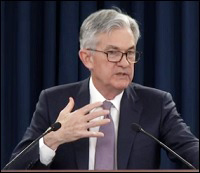By Pam Martens and Russ Martens: March 16, 2020 ~
Last evening, it became painfully clear that the Board of Governors at the Federal Reserve do not understand the inner workings of Wall Street. After prattling on for months about the need to rebuild “ample reserves” at the behemoth Wall Street banks after the Fed was forced on September 17 to become the liquidity provider of last resort to the tune of $9 trillion cumulatively thus far, the Fed flipped its thinking on a dime yesterday and sent markets into a panic. As of 8:55 a.m. this morning, S&P 500 futures are locked, limit down, suggesting a steep drop in stocks at the open of trading at 9:30 a.m.
Along with a series of other measures to prop up liquidity on Wall Street, the Federal Reserve Board of Governors announced last evening that it “has reduced reserve requirement ratios to zero percent effective on March 26, the beginning of the next reserve maintenance period. This action eliminates reserve requirements for thousands of depository institutions and will help to support lending to households and businesses.”
The Fed also said it is “encouraging banks to use their capital and liquidity buffers.”
The Fed characterized all of its actions, which included a new round of quantitative easing where it will buy up $500 billion of U.S. Treasury securities and $200 billion in mortgage-backed securities, as helping the consumer and small businesses. One brave reporter on the Fed’s press conference last evening, which was held by telephone, asked exactly how eliminating reserves was going to help businesses and consumers.
Howard Schneider of Reuters questioned Fed Chairman Jerome Powell as follows:
“Could you describe any discussions you’ve had in coordination with the major banks – this whole talk of drawing down liquidity, drawing down capital buffers, how far can they draw it down, how much do you think they can put out now to customer finance? Did you get explicit agreements from them that this will go to customer finance and not something else?”
Powell made it clear that the Fed had not gotten any contractual guarantees from the banks. He said: “We’ve given broad general guidance to the banks.”
During the 2007 to 2010 financial crisis, when the Fed secretly funneled more than $16.1 trillion in loans to the Wall Street banks according to an audit by the non-partisan watchdog of Congress, the Government Accountability Office, the banks continued to charge consumers double-digit interest rates on their credit cards as the banks borrowed significant sums from the Fed at less than one-half of one percent interest. A large part of the loans from the Fed went to the Wall Street banks’ trading operations in London.
Large corporations and institutions hold significant deposits at these banks that exceed federal deposit insurance limits. Without those bank reserves parked safely at the Federal Reserve, these mega banks are viewed far more skeptically as a safe place to park liquid funds.
As of September 30, the latest data available from the Office of the Comptroller of the Currency, five of the Wall Street banks held $230 trillion in notional (face amount) of derivatives, which represents 85 percent of all derivatives held by the more than 5,000 banks and savings associations in the United States. Banks that get on the wrong side of a derivatives trade have to regularly post extra collateral to their counterparty. The Fed’s bizarre action in removing reserve requirements at a time when public confidence in the banks is critical, raises concerns across Wall Street that at least some of these banks may desperately need access to those reserves to post collateral on derivative trades.
As we previously reported, it was JPMorgan Chase’s massive drawdown last year of more than half of its reserves that is viewed on Wall Street as contributing to the repo loan crisis and forcing the Fed to become the feeding tube to Wall Street for the first time since the financial crisis. (See The Fed Fears an Explosion on Wall Street: Here’s How JPMorgan Lit the Fuse.) Notice the date on that article of October 28. That was long before the coronavirus became an issue in China or anywhere else in the world.
The concern about toxic assets at the Wall Street mega banks is heightened by the staggering size of the losses these banks have been experiencing in their share prices. (See our report from last week: Another Dangerous Virus Hits the U.S. – Wall Street Bank Contagion.)
Other actions announced by the Fed last evening were a reduction in its federal funds rate to 0 to 1/4 percent – the rate it got down to during the last financial crisis; allowing 90-day loans from its Discount Window for banks running short of cash; cutting the Discount Window’s borrowing rate by a stunning 1.5 percent to 0.25 percent, effective today.
During the telephone press conference, Powell stated: “I also want to add, though, that we’re strongly focused on financial stability. We monitor it carefully; we’ve built a very resilient financial system; the banks are highly capitalized; lots of liquidity; much better at understanding and managing their risks, they’re resilient to stress…”
Shortly after the stock market opened this morning the Dow Jones Industrial Average had lost 2,771 points. The market is now subject to a circuit breaker and halted from trading for 15 minutes. That doesn’t sound like the market believes that the mega Wall Street banks are “much better at understanding and managing their risks” or that they are “resilient to stress.”


